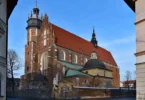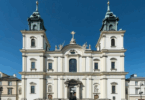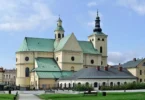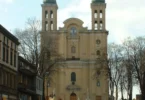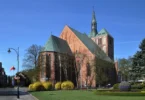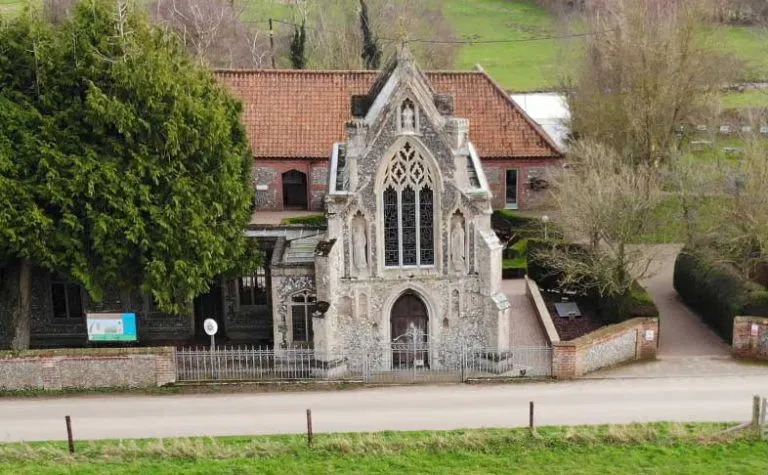
Introduction
The Basilica of Our Lady of Walsingham, informally known as the Slipper Chapel or the Chapel of Saint Catherine of Alexandria, is a Catholic basilica in Houghton Saint Giles, Norfolk, England. Built in 1340, it was the last chapel on the pilgrim route to Walsingham.
Pope Pius XII granted a canonical coronation to the venerated statue of the Blessed Virgin Mary under the title of Our Lady of Walsingham presently enshrined within the chapel on 15 August 1954.
Pope Francis raised the sanctuary to the status of a minor basilica via an apostolic decree on 27 December 2015.
When the Slipper Chapel was built, Walsingham was second only to Canterbury in the ranks of importance in English pilgrimage.
History of Basilica of Our Lady of Walsingham, England

In 1538, after King Henry VIII’s English Reformation, the chapel fell into disuse and was variously used as a poor house, a forge, a cowshed and a barn. In 1863, the chapel was identified by a wealthy local woman, Miss Charlotte Pearson Boyd (1837–1906), a convert to Catholicism from Anglicanism.
She bought the building from the farm owner in 1896, restored it and then donated the chapel to Downside Abbey for Catholic use. On 6 February 1897, the chapel was re-established as a shrine authorising the image for public veneration by papal rescript from Pope Leo XIII. It was restored in 1904 by Thomas Garner.
On the Feast of the Assumption, 15 August 1934, the Bishop of Northampton, Laurence Youens celebrated the first public Mass in the Slipper Chapel for four hundred years, and two days later Cardinal Francis Bourne led a national pilgrimage of the Catholic bishops of England and Wales and more than 10,000 people to the shrine. From this date it became the Catholic National Shrine of Our Lady.
Our Lady of Walsingham

Our Lady of Walsingham is a title of Mary, mother of Jesus venerated by Catholics, Western Rite Orthodox Christians, and some Anglicans associated with the Marian apparitions to Richeldis de Faverches, a pious English noblewoman, in 1061 in the village of Walsingham in Norfolk, England. Lady Richeldis had a structure built named “The Holy House” in Walsingham which later became a shrine and place of pilgrimage.
In passing on his guardianship of the Holy House, Richeldis’s son Geoffrey left instructions for the building of a priory in Walsingham. The priory passed into the care of the Canons Regular of Saint Augustine, sometime between 1146 and 1174.
By a rescript of 6 February 1897, Pope Leo XIII blessed a new statue for the restored ancient sanctuary of Our Lady of Walsingham. This was sent from Rome and placed in the Holy House Chapel at the newly built Catholic parish church of King’s Lynn (the village of Walsingham was within the parish) on 19 August 1897 and on the following day the first post-Reformation pilgrimage took place to the Slipper Chapel at Walsingham, which was purchased by Charlotte Boyde in 1895 and restored for Catholic use. Hundreds of Catholics attended the pilgrimage and committed themselves to an annual pilgrimage (from 1897 to 1934 on Whitsun) to commemorate this event.
Pope Pius XII granted a canonical coronation to the Catholic image via the Papal Nuncio, Bishop Gerald O’Hara, on 15 August 1954 with a gold crown funded by her female devotees, now venerated in the Basilica of Our Lady of Walsingham.
The Statue of Our Lady of Walsingham

All Catholic pilgrimages are centred on the Slipper Chapel, where the statue of Our Lady of Walsingham is enthroned. The statue is of course a modern one but has been modelled as closely as possible on the medieval statue. Our Lady is depicted in traditional style seated on a simple chair of state with the Child Jesus on her knee. She wears a Saxon crown in token of her ancient queen-ship and carries the lily of purity.
The statue is not remarkable in itself but the sincere attempt to recreate the form of the old statue when the only available evidence came from circular pilgrim medallion is praiseworthy, and the result is pleasing and devotional.
It is a thought-provoking statue with theological implications so typical of the Middle Ages. The Child seems to dominate. It is not so much a statue of the Mother with the Child as a statue of the Child with the Mother in the background. The Child holds the Book of Gospels with one hand and with the other seems to shield his Mother from attack.
In recent years Our Lady has been depicted frequently as a lonely young girl. Our Lady of Lourdes and Our Lady of Fatima stand alone. Our Lady of Walsingham emphasises her Motherhood and her continual effort to present her Son to the world.
The statue has an importance of its own not only because of its situation at the heart of the National Shrine, but because it is one of the few statues in the world to be crowned in the name of the Pope. The crowning was during a Marian Year, on 15th August 1954, by Archbishop O’Hara, who was to become Apostolic Delegate to Great Britain. At the same time the women of England presented a costly crown of gold and jewels which is placed on the statue at certain times.
The devotion to Our Lady of Walsingham received a further mark of papal approval during the visit to Britain of Pope John Paul II in 1982. The statue was taken from the Slipper Chapel to Wembley Stadium and occupied a place of honour on the altar while the Pope celebrated Mass in the presence of many thousands of people.
Marian Apparition

According to the tradition, in a Marian apparition to Lady Richeldis, the Blessed Virgin Mary fetched Richeldis’ soul from England to Nazareth during a religious ecstasy to show the house where the Holy Family once lived and in which the Annunciation of Archangel Gabriel occurred. Richeldis was given the task of building a replica house in her village, in England. The building came to be known as the “Holy House”, and later became both a shrine and a focus of pilgrimage to Walsingham.
The modern wooden image was carved in Oberammergau, Germany, and was once associated with the Virgin of Mercy under the venerated Marian title of Our Lady of Ransom, sometimes locally worded as “Our Lady of the Dowry”. The popularity of the Marian cult gradually localized the place of devotion as “Our Lady of Walsingham”.

Holy House and Pilgrimages
The historian J. C. Dickinson argues that the chapel was founded in the time of Edward the Confessor, about 1053, the earliest deeds naming Richeldis, the mother of Geoffrey of Favraches, as the founder. Dickinson claims that in 1169, Geoffrey granted “to God and St Mary and to Edwy his clerk the chapel of our Lady” which his mother had founded at Walsingham with the intention that Edwy should found a priory. These gifts were, shortly afterwards, confirmed to the Augustinian Canons of Walsingham by Robert de Brucurt and Roger, Earl of Clare.
However, historian Bill Flint (2015) has disputed the foundation date established by Dickinson, arguing that the 1161 Norfolk Roll refers to the foundation of the priory only and not the shrine. Flint supports the earlier date of 1061 given in the Pynson Ballad and claims that in this year, Queen Edith the Fair, Lady of the Manor, was the likely Walsingham visionary.
By the time of its destruction in 1538 during the reign of Henry VIII, the shrine had become one of the greatest religious centres in England and Europe, together with Glastonbury and Canterbury. It had been a place of pilgrimage during medieval times, when due to wars and political upheaval, travel to Rome and Santiago de Compostela was tedious and difficult.
It was also a place of pilgrimage for Queen Catherine of Aragon who was a regular pilgrim. Likewise, Anne Boleyn also publicly announced an intention of making a pilgrimage but it never occurred. Its wealth and prestige did not, however, prevent its being a disorderly house. The visitation of Bishop Nicke in 1514 revealed that the prior was leading a scandalous life and that, among many other things, he treated the canons with insolence and brutality; the canons themselves frequented taverns and were quarrelsome. The prior, William Lowth, was removed and by 1526 some decent order had been restored.
Destruction
The suppression of the monasteries was part of the English Reformation. On the pretext of discovering any irregularities in their life, Thomas Cromwell organised a series of visitations, the results of which led to the suppression of smaller foundations (which did not include Walsingham) in 1536. Six years earlier the prior, Richard Vowell, had signed their acceptance of the king’s supremacy, but it did not save them. Cromwell’s actions were politically motivated, but the canons, who had a number of houses in Norfolk, were not noted for their piety or good order.
The prior was evidently compliant but not all of the community felt likewise. In 1537, two lay choristers organised “the most serious plot hatched anywhere south of the Trent”, intended to resist what they feared, rightly as it turned out, would happen to their foundation. Eleven men were executed as a result. The sub-prior, Nicholas Milcham, was charged with conspiring to rebel against the suppression of the lesser monasteries, and on flimsy evidence was convicted of high treason and hanged outside the priory walls.
The suppression of the Walsingham priory came late in 1538, under the supervision of Sir Roger Townshend, a local landowner. Walsingham was famous and its fall symbolic.
The priory buildings were looted and largely destroyed, but the memory of it was less easy to eradicate. Sir Roger wrote to Cromwell in 1564 that a woman of nearby Wells (now called Wells-Next-The-Sea) had declared that a miracle had been done by the statue after it had been carried away to London. He had the woman put in the stocks on market day to be abused by the village folk but concluded “I cannot perceyve but the seyd image is not yett out of the sum of ther heddes.”
The site of the priory with the churchyard and gardens was granted by the Crown to Thomas Sydney. All that remained of it was the gatehouse, the great east window arch and a few outbuildings. The Elizabethan ballad, “A Lament for Walsingham”, expresses something of what the Norfolk people felt at the loss of their shrine of Our Lady of Walsingham.
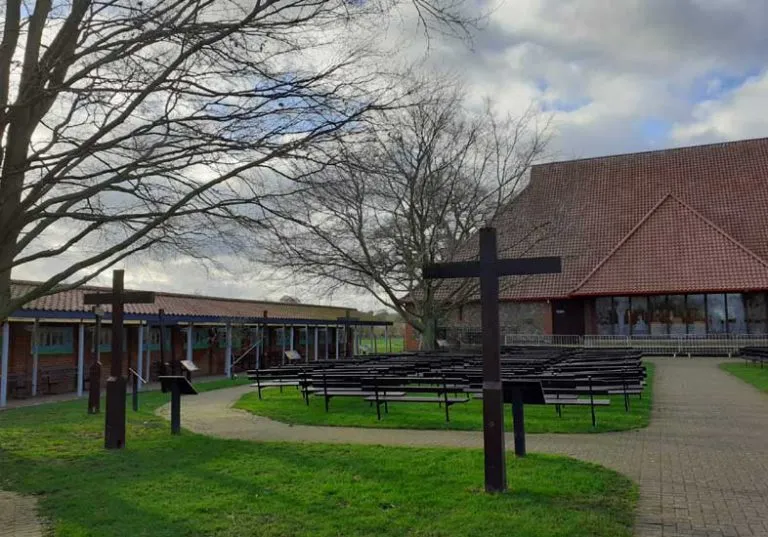
Modern Revival
After nearly four hundred years the 20th century saw the restoration of pilgrimage to Walsingham as a regular feature of Christian life in the British Isles and beyond. There are major Catholic and Anglican shrines in Walsingham, as well as a smaller Orthodox one.
Slipper Chapel
In 1340, the Slipper Chapel was built at Houghton St Giles, a mile outside Walsingham. This was the final “station” chapel on the way to Walsingham. It was here that pilgrims would remove their shoes to walk the final “Holy Mile” to the shrine barefoot. Hence the designation ‘Slipper’ Chapel.
In 1896, Charlotte Pearson Boyd purchased the 14th-century Slipper Chapel, which had seen centuries of secular use, and set about its restoration.
In 1897, Pope Leo XIII re-established the Holy House, rebuilt at the Church of the Annunciation at King’s Lynn, as a Catholic shrine (Walsingham was part of this Catholic parish in 1897). At the same time, a statue, carved at Oberammergau and blessed by Pope Leo XIII was placed there. Since 1934, the restored 14th-century Slipper Chapel has been the National Shrine of Our Lady of Walsingham.
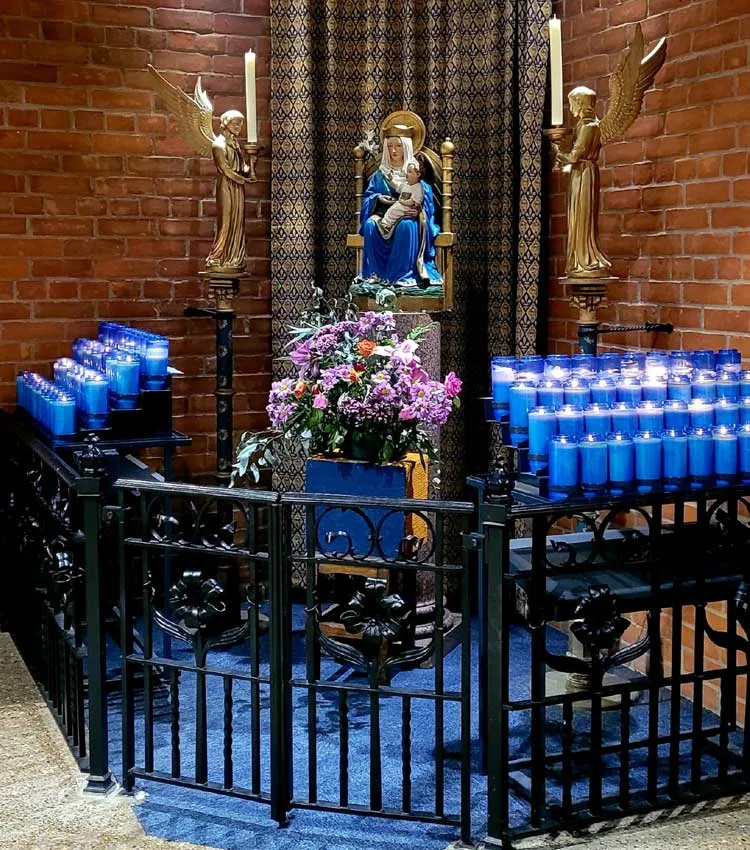
Anglican Shrine
The Anglican Shrine of Our Lady of Walsingham was created in 1931, and enlarged in 1938. In 1921, Fr Hope Patten was appointed Vicar of Walsingham. He set up a statue of Our Lady of Walsingham, in the Parish Church of St Mary. It was based on the design of the original statue, as found on the medieval seal of Walsingham Priory.
As the number of pilgrims to the site increased, a new chapel was dedicated in 1931 and the statue was moved to it in an elaborate translation procession on 15 October 1931. The chapel was extended in 1938 to form the current Anglican shrine church.
Canonical Coronation of the Image
Twenty years later on 15 August 1954, Pope Pius XII delegated his Papal nuncio, Monsignor Gerald O’Hara to crown the venerated image of the Virgin Mary under the same title in his apostolic name, funded by gold donated by female devotees and accompanied by his papal bull from the Sacred Congregation of Rites.
Moments after the coronation ceremony, two white doves descended on the lap of the image, which was considered miraculous by devotees. The ceremony was accompanied by both British and American pilots who sponsored the security for the event, and devotees who processed barefoot in the “Holy Mile” leading into the shrine.
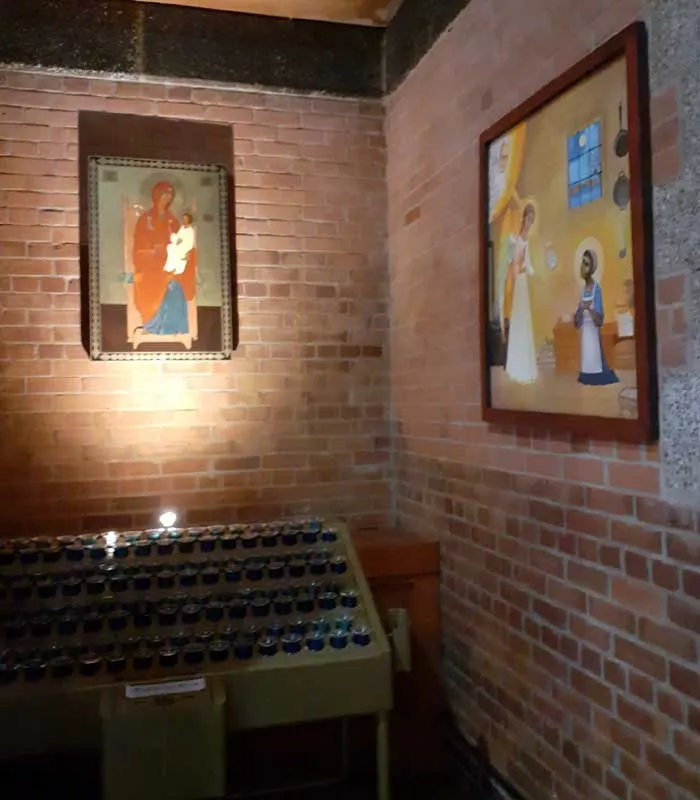
Holy Mile
Many modern pilgrims remove their shoes at the Slipper Chapel and walk the last mile, called the “Holy Mile”, into Walsingham barefoot. The Slipper Chapel contains a stone statue of the Virgin Mary carved by Marcel Barbeau. The statue was taken to Wembley to be blessed by Pope John Paul II when he visited England on 29 May 1982.
Each year on 8 September, on the Feast of the Birth of Our Lady, the statue of Our Lady of Walsingham is carried for several miles in a procession which begins at the Slipper Chapel.
The Grade II listed presbytery was built in 1904, probably by Garner. Today, the complex surrounding the Slipper Chapel includes a Chapel of Reconciliation, built in 1982, which can seat up to 350 people for services and can be opened towards the pilgrimage area in occasion of bigger ceremonies; a bookshop; and a tearoom.
In 2007 the Slipper Chapel featured in the BBC documentary series How We Built Britain, presented by David Dimbleby.
Status as a Minor Basilica
Pope Francis raised the sanctuary to the status of a minor basilica on 27 December 2015, along with the Catholic shrine of Our Lady of Walsingham via a pontifical decree from the Congregation for Divine Worship and the Discipline of the Sacraments.
Feast Day - 24th September & 15th October
The feast day of Our Lady of Walsingham is kept on 24 September in both the Anglican and Catholic churches. Anglicans, especially in the Society of Our Lady of Walsingham and at the Anglican shrine, keep an additional feast of translation on 15 October annually, the anniversary of the translation of the image from Walsingham’s parish church to the shrine church in 1931. In the United States several local churches keep the translation (15 October) as the principal feast of Our Lady of Walsingham, including the Episcopal Church, ROCOR Western Rite, and the Antiochian Orthodox Christian Archdiocese of North America.
Mass Time
Every Days
Church Visiting Time
Contact Info
Houghton Street Giles, Walsingham,
NR22 6AL, United Kingdom.
Phone No.
Tel : +44 1328 820 495
Accommodations
How to reach the Basilica
Heathrow Airport (LHR) in London, United Kingdom is the nearby Airport to the Basilica.
Dereham Train Station in the town of Dereham in the English county of Norfolk, United Kingdom is the nearby Train Station to the Basilica.


